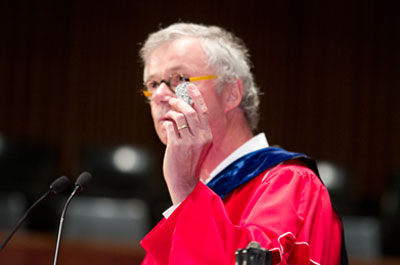Stone for Stone

by MaryAlice Bitts-Jackson
President William G. Durden '71 wasn't seeking a life touchstone when he took a pleasure trip to Germany two summers ago, but that's exactly what awaited him there. Now, the insights he brought back from that trip will touch generations of students as well.
This year, the college launched a new Convocation tradition that cuts to the core of the liberal-arts education: helping students embark on the path of an examined, purposeful life. And while it's steeped in the history of a centuries-old American college, the tradition also draws inspiration from a far-off land.
Inspiration strikes
A Dickinson alumnus and Fulbright scholar who majored in German and philosophy as an undergraduate and has served as the college's president since 1999, Durden traveled to Dresden with his wife, Dr. Elke Durden, eager to tap into the city's vibrant cultural scene and storied history. They visited the site of the Dresden Frauenkirche, a cathedral that had been completely destroyed by firebombing during World War II.
Near the church they discovered a pile of small stones and a sign urging visitors to take a stone home. The stones had been carried during a recent religious procession from the rebuilt Frauenskirche to a rebuilt synagogue as reminder of the atrocities of the war and of the importance of just and purposeful living. The sign exclaimed: "History is concrete."
Moved by the overarching message, Durden pocketed one of the stones.
Two summers later, as he prepared for his final semester as Dickinson's president, he recalled the power of that symbolic experience. "The stone is filled with meaning," he later explained. "Most profoundly, it reminds us all of the extreme danger of harm of unmitigated hate, intolerance, misinformation, greed, ungrounded idealism, ignorance and racism … It also has everything to do with identity—who one is and how one will act."
Inspiration struck. A new college tradition was born.
During the Convocation ceremony that kicks off each new academic year, incoming students are now invited to pick up a piece of limestone, mined from the quarry that produced materials to build the college's historic original building, Old West. (Four years later at graduation, they will either keep the limestone for lifelong reference and reflection or give it back to the college to be passed on to an incoming student.) New students also are now encouraged to write a letter articulating their aspirations both for themselves and their community. They will submit their letters to college officials during the Convocation ceremony, and the letters will be returned, unopened, at the start of the following year.
Like the Dresden stone that inspires these gestures, Durden said, the limestone fragments are tangible links to a wider, intergenerational community and to lessons collectively learned. Both the limestone pieces and the Convocation letters also are concrete reminders to periodically take inventory of the paths the students travel—as individuals and community members—and the hopes and plans they'd articulated in writing at the start of their college careers.
Why limestone?
Using limestone as a symbol of shared history and values, the college taps a deep well of tradition. Dickinson's iconic, original buildings are constructed of this plentiful area resource, which has for centuries heightened and defined the campus' aesthetic. More important, limestone also carries metaphorical weight, as the foundation on which the college rests.
The associations between the college and the stone are so strong, in fact, that limestone has entered the college lexicon as a symbol of the campus itself; when students graduate, they are said to move "beyond the limestone." This is, however, the first time that the college has ceremoniously used this weighty symbol to infuse new layers of meaning into the on-campus experience.
"Until I picked up that stone in Dresden and thought about its representative history, intentionality and concreteness as stone, I never appreciated fully the need to invest our limestone with more definition and meaning-personal meaning for each and every student," Durden said. "With this new tradition we hope to capture concretely a sense of purpose embodied in our precious limestone for generations of Dickinsonians to come."
Inherited responsibilities
During the Aug. 25 Convocation ceremony, Durden bequeathed the stone he'd picked up in Dresden to the college's archives and described the far-reaching effects of the mindset, values and actions the limestone represents.
He explained that while the knowledge and skills undergraduates acquire are important, the next four years also are a time of intense identity formation. The actions students take and decisions they make will therefore set a pattern for who they become, both at college and beyond. "You inherit a responsibility of defining who you are and how you think and feel and act for a lifetime, and your identity is of your making," he stressed, adding that the exercise of carrying a limestone "reminds us of the concreteness of the college experience, of our community of opportunity and obligation and of the self-responsibility of identity."
By living intentionally, he concluded, the students embark on the path of their conscious choosing. And by reflecting on the paths of those who walked before them, they become fully part of something greater than themselves—something that they will continually help create and re-create.
As Durden put it, "We build communities stone by stone, thought by thought, action by action."
Learn more about [LINK] President William G. Durden '71.
Read President Durden's [LINK] 2012 Convocation speech.
See photos of the 2012 Convocation [LINK] sign-in ceremony.
Published August 31, 2012